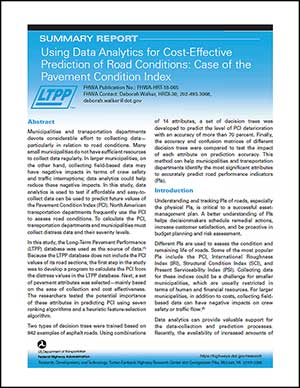U.S. Department of Transportation
Federal Highway Administration
1200 New Jersey Avenue, SE
Washington, DC 20590
202-366-4000
Federal Highway Administration Research and Technology
Coordinating, Developing, and Delivering Highway Transportation Innovations
| SUMMARY REPORT |
| This summary report is an archived publication and may contain dated technical, contact, and link information |
| Publication Number: FHWA-HRT-18-065 Date: November 2018 |
Publication Number: FHWA-HRT-18-065 Date: November 2018 |
PDF Version (998 KB)
HTML Version of Errata for FHWA-HRT-18-065
PDF files can be viewed with the Acrobat® Reader®
Municipalities and transportation departments devote considerable effort to collecting data—particularly in relation to road conditions. Many small municipalities do not have sufficient resources to collect data regularly. In larger municipalities, on the other hand, collecting field-based data may have negative impacts in terms of crew safety and traffic interruptions; data analytics could help reduce these negative impacts. In this study, data analytics is used to test if affordable and easy-to-collect data can be used to predict future values of the Pavement Condition Index (PCI). North American transportation departments frequently use the PCI to assess road conditions. To calculate the PCI, transportation departments and municipalities must collect distress data and their severity levels.
In this study, the Long-Term Pavement Performance (LTPP) database was used as the source of data.(1) Because the LTPP database does not include the PCI values of its road sections, the first step in the study was to develop a program to calculate the PCI from the distress values in the LTPP database. Next, a set of pavement attributes was selected—mainly based on the ease of collection and cost effectiveness. The researchers tested the potential importance of these attributes in predicting PCI using seven ranking algorithms and a heuristic feature-selection algorithm.
Two types of decision trees were trained based on 942 examples of asphalt roads. Using combinations of 14 attributes, a set of decision trees was developed to predict the level of PCI deterioration with an accuracy of more than 70 percent. Finally, the accuracy and confusion matrices of different decision trees were compared to test the impact of each attribute on prediction accuracy. This method can help municipalities and transportation departments identify the most significant attributes to accurately predict road performance indicators (PIs).
